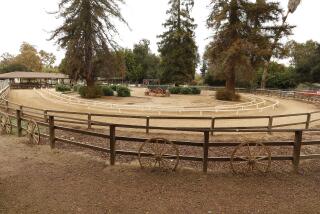Officials Vow to Resist Oil Line Through Glendale
Angered over state and federal approval of a crude-oil pipeline route beneath five miles of heavily traveled city streets, Glendale officials said this week that they will continue fighting for routing of the pipeline through Griffith Park.
Glendale officials received notice Monday that the state Department of Transportation and the U. S. Forest Service, the two agencies charged with approving the environmental impact report on the pipeline, approved in late August an EIR that establishes the route through Glendale.
Glendale City Council members agreed Tuesday to ask Burbank officials to join them in protesting a stretch of the 135-mile Angeles Crest Pipeline that would zig-zag through both cities.
Glendale Councilman Carl W. Raggio, an aerospace engineer, complained that the recently approved route “deliberately goes out of its way” to unfairly burden Glendale and Burbank residents with traffic snarls during construction and with the potential for oil spills.
The 30-inch pipeline would carry about 330,000 gallons of crude oil daily from the San Joaquin Valley to oil refineries in Long Beach, El Segundo, Wilmington and Carson.
“We asked that consideration be given to its routing through Griffith Park,” Raggio said after the meeting. “. . . If the pipeline breaks, you can certainly react to it that much better in light of the fact that there’s no housing or traffic in Griffith Park.”
May Request
Raggio suggested that Caltrans and Forest Service officials never considered the Griffith Park route, which Glendale council members requested in May. If they had, Raggio said, officials would have taken much longer to reach a decision.
“I have the impression that minds had been made up and we were just going through the motions. And that irritates me,” the councilman said.
But Caltrans Deputy District Director Joseph Sanchez denied Raggio’s statement and said that officials “found no reason to push it to another location.”
“If you did have a rupture in the pipeline . . . is it better for it to occur on a city street or in a park?” Sanchez asked. “That is a judgment value.”
In May, Glendale Planning Director Gerald J. Jamriska warned council members about the dangers and inconveniences posed by routing the pipeline through the city.
Jamriska stated in a report that pipeline construction would severely disrupt traffic, particularly along Colorado Street and part of Central Avenue that borders the Glendale Galleria. The report also listed several environmental concerns, including the effect of spills on the city’s soil and groundwater.
As a result, Glendale council members asked Caltrans and Forest Service to opt for the Griffith Park route.
A consortium of four oil companies that is backing the $225-million project originally proposed the park route, but backed away from it earlier this year after nearby homeowners and golfing interests attacked the plan.
The pipeline would enter Glendale from Burbank at Sonora Avenue and run east to San Fernando Road. It would follow San Fernando Road south, then head east at Colorado Street and pass the southern edge of the Galleria.
It would then turn south on Central Avenue and rejoin San Fernando Road and continue east to Fletcher Drive, south to Rowena Avenue and west to Hyperion Avenue in Silver Lake.
Proponents of the pipeline engendered the wrath of Glendale officials by saying that the route traverses a largely industrial area in Glendale.
“That is patently false. They obviously don’t know Glendale,” said Councilman Jerold F. Milner, who added that the area is largely residential and commercial.
More to Read
Sign up for Essential California
The most important California stories and recommendations in your inbox every morning.
You may occasionally receive promotional content from the Los Angeles Times.









